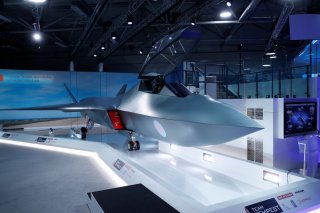The Tempest Stealth Fighter's Can't Hide Its Achilles Heel
There's no hiding from the cost.
Here's What You Need to Remember: The Tempest project’s current partners include Italy and Sweden. The government, which has always been clear that the financial solvency of the Tempest project hinges on securing a steady stream of foreign investment, is also currently exploring partnership opportunities with Japan.
The United Kingdom is forging ahead with its ambitious project to produce a home-grown stealth warplane, even as it strives to retain its status as one of the core partners in the F-35 stealth fighter jet program.
London is doubling down on plans to indigenously produce its upcoming BAE Systems Tempest jet fighter, a next-generation successor to the United Kingdom’s Eurofighter Typhoon fleet. In a March 2021 Command Paper to Parliament, the British Ministry of Defense (MOD) reiterated that the Tempest fighter will be a major procurement priority into the coming decades. “Tempest will exploit our unique industrial base to create a 6th generation combat air enterprise centred in the UK,” the paper reads. “This fully digital enterprise will transform delivery, achieving pace and lowering cost and disrupting traditional approaches to defence procurement.”
The Tempest project’s current partners include Italy and Sweden. The government, which has always been clear that the financial solvency of the Tempest project hinges on securing a steady stream of foreign investment, is also currently exploring partnership opportunities with Japan.
As with most other next-generation fighters, the Tempest fighter will offer its own form of sensor fusion. The fighter’s ambitious Tempest’s Multi-Function Radio Frequency System (MFRFS) data collection protocols will be “four times as accurate as existing sensors in a package 1/10th the size,” according to defense contractor and Tempest partner Leonardo. The MFRFS will filter the battlefield information it collects through its onboard processor suite, generating a dynamic picture of the battlefield that can include everything from enemy movements to terrain layout. Like the F-35 jet, the Tempest fighter can also act as a flying command and control center by feeding some of that information to nearby friendly units. The Tempest project is betting big on future-oriented experimental avionics systems, with BAE Systems working on a “wearable cockpit” interface that replaces both analog and digital inputs with augmented reality (AR) display, supported by an integrated network of artificial intelligence (AI) features.
The Tempest’s project’s preoccupation with unorthodox prototype technologies extends to its weapons loadout. At a Rome seminar on missile defense, Italy’s General Enzo Vecciarelli suggested that the Tempest fighter could incorporate directed-energy weapons to counter hypersonic missiles. “On Tempest there will be a large amount of energy available and I don’t rule out the use of directed energy,” Vecciarelli said. It was previously confirmed that the Tempest fighter will also carry hypersonic missiles of its own, in addition to being able to operate drone swarms.
As the Tempest project moves further along in the development stage, the fate of the UK’s massive F-35 jet procurement plans hangs in the balance. As a “Level 1” partner in the F-35 program, London previously stated it will purchase as many as 138 units of Lockheed Martin’s fifth-generation stealth fighter. London, however, has so far only ordered forty-eight F-35 jet fighters. The MOD says it plans to “grow the [F-35] Force, increasing the fleet size beyond the 48 aircraft that we have already ordered,” but is dragging its feet on whether or not it remains committed to an acquisition target of 138 F-35 fighters.
The Tempest fighter is projected to reach Initial Operating Capability (IOC) by 2035.
Mark Episkopos is a national security reporter for The National Interest.
Image: Reuters.

